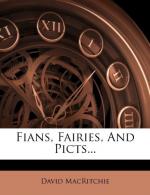This last, however (Plates XI. and XII.), represents another variety of earth-house, the chambered mound or beehive, with an underground gallery leading to it. Of this kind two examples are here shown. And in Plates I. and XIII. will be seen specimens of wholly subterranean structures. It is difficult, and indeed hardly necessary, to distinguish between one variety and another of what is practically the same kind of building; but to this last class the term “earth-house” is most frequently accorded in Scotland. In the broader dialect it is “yird-house” or “eirde-house,” which at once recalls the form “jord-hus” in the saga which tells of Leif’s adventure underground in Ireland. The term weem is also applied to these places in Scotland. This is merely a quickened pronunciation of the Gaelic uam (or uamh), a cave; and it reminds one that, both in Gaelic and in English, the word “cave” is by no means restricted to a natural cavity. Indeed, one of the two artificial structures under consideration is known as Uamh Sgalabhad, “the cave of Sgalabhad.” Another old Gaelic name for those underground galleries is “tung or tunga";[61] while another name, by which they are known in Lewis is tigh fo thalaimh,[62] or “house beneath the ground.”
“Martin, in his description of the Western Islands, printed in 1703, when their use would appear to have been still remembered, speaks of them [these underground structures] as ’little stone-houses, built under ground, called earth-houses, which served to hide a few people and their goods in time of war.’"[63] Dean Monro writes, “There is sundry coves and holes in the earth, coverit with hedder above, quhilk fosters many rebellis in the country of the North head of Ywst” [North Uist].[64] “From O’Flaherty’s description of West Connaught, written in 1684, it appears,” observes Captain Thomas,[65] but referring more strictly to the beehive-house, “that this style of dwelling had already become archaic.” For, although that writer mentions certain “cloghans” as being still inhabited, holding forty men in some cases, yet he says they were “so ancient that nobody knows how long ago any of them were made.” Of the underground galleries another writer says: “It has been doubted if these houses were ever really used as places of abode.... But as to this there can be no real doubt. The substances found in many of them have been the accumulated debris of food used by man.... Ornaments of bronze have been found in a few of them, and beads of streaked glass. In some cases the articles found would indicate that the occupation of these houses had come down to comparatively recent times."[66]
In conclusion, these remarks of Captain Thomas, who made so thorough a study of the subject, may be quoted:—




